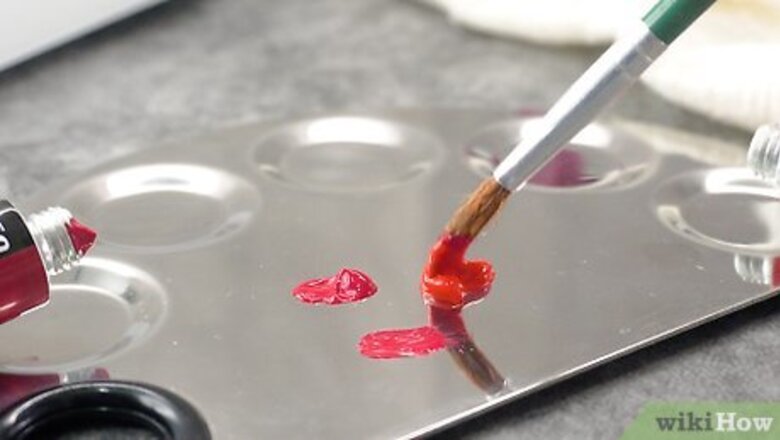
views
Using Red, Green, or Blue Paint
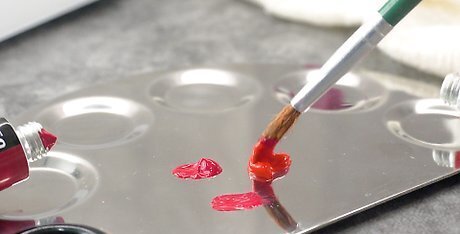
Mix a deeper shade of red with your base red. Mixing 2 shades of the same color together is the best option for making minor changes to a red paint’s color profile. Modify a red paint by mixing it with a darker shade of red that is the same brand and type of paint. Add maroon, burgundy, or crimson to a light red and mix it thoroughly with a mixing stick or brush so that the 2 shades combine thoroughly. This is the simplest way to make minor adjustments to your red. Stick to the same category of paint when mixing. If your base paint is acrylic, mix it with other acrylics. If your base paint is a semi-gloss oil-based paint, mix it with other semi-gloss oil-based paints. If you mix different types of paint, they may blend into an inconsistent texture or color. If you’re working in low-light conditions, it can be hard to see a difference in a red paint when you mix it with another red.
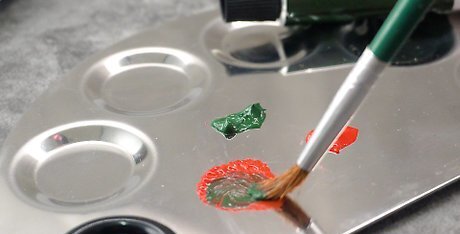
Add a little bit of green paint to make a deeper red. Complimentary colors can be combined to make different shades of brown. If you want to push a red into a darker shade without adding black, use a little bit of green to give your red paint a brownish undertone. Start with a combination that is 1-part green to every 10-parts red before increasing the amount of green that you’re using. Darker colors will radically change a lighter paint rapidly. Err on the side of caution by starting with a conservative amount of green before you go further. You can identify a color’s complimentary color by referring to a color wheel and looking for the color that is on the opposite side of your red. If you add black to a color, it will naturally absorb more light. Adding a little green is a good way to keep a red vibrant and vivid without making a room feel smaller or a painting appear flatter.

Use an analogous shade of blue to make a red darker and muted. A violet undertone will make a shade of red darker and deeper. Mix darker reds with softer blues and lighter reds with deeper blues to darken your red paint. Start by mixing 1-part of your analogous color and 10-parts of your red before you increase the amount of blue that you’re adding.Tip: Mixing analogous colors often makes a paint feel dynamic and unique. If you’re trying to make a statement on an accent wall or make a focal point pop, consider this option. Analogous colors refer to colors that are next to one another on the color wheel, like light green and bright yellow or dark orange and light red. If you use too much blue, your red will end up looking purple.
Mixing Reds with Neutral Colors
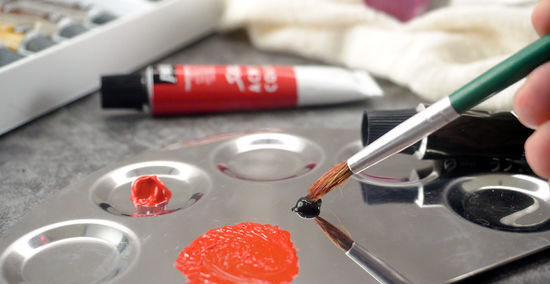
Add black to change the shade of red and make it richer. Combining black with any color will create a darker shade of that color. This is the most straightforward way to make a color darker. Start small, with 1-part black for every 30-parts of red to ensure that you don’t overdo it when mixing your paints. Black is the strongest color in terms of how potent it is at modifying a paint color, so work in smaller increments when increasing the amount of black in a mixture.Warning: It is very hard to reverse the changes to a color if you add black because it is such a potent pigment. In addition, black changes a color so quickly that it can be hard to identify how much you need. Many painters don’t like mixing primary colors with black because it muddies the color and might not look dynamic
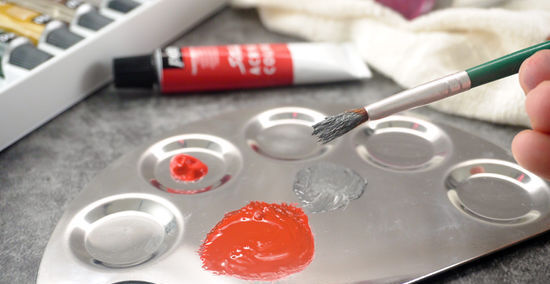
Combine red with a gray to make a darker, flat red. Start with 1-part gray to 15-parts red. Mixing a paint with gray instead of black means that you’re adding some white to your color, which will create a more neutral impression. The white and the black will cancel each other out in terms of vibrancy, resulting in a flatter, muted red. Combine red and flat gray if you’re trying to make your wall or painting feel neutral. If you’re worried about making a room feel smaller when you paint a wall red and gray, use a lighter shade of gray. It will mute the red without making it feel dark. You can mix gray by combining white and black.

Mix a red with a brown to make a muted, earthy shade of red. Start with 1-part brown to 20-parts red. Choosing the right shade of brown to mix with a red can be difficult because brown can contain a wide range of colors. Generally speaking, the lighter your brown is, the more orange your red will appear to be. Opt for small amounts of a darker brown if you’re working with a primary red. You can add black or yellow to your brown-red mixture to make it burgundy.
Applying a Second Coat and Mixing Materials

Add another coat of the same red to make the color richer. After your first coat has dried, you can make a red richer in color by adding a second coat. This works particularly well if you’re working with a shade that is deeper than primary red. Simply cover your canvas, wall, or item a second time using the same paint that you used the first time. If you’re painting a lighter shade of red, adding a second coat will make it more vibrant, which could actually make it look lighter.

Apply a coat of maroon, burgundy or crimson to a lighter shade to deepen the hue. If your red is too bright, you can deepen the hue by adding a deeper color. Choose a red that is a few shades darker than your current red and apply it on top of your first coat to create a stronger color. This method works best with paints that are water-based or translucent. Watercolor paints don’t often come in different shades. If you’re painting with watercolors, use less water to make a color darker. You can use color swatches to identify the color of your wall. Hold up shades of red against the wall until you find a swatch that blends with your wall perfectly. Color swatches are normally organized with the lightest tone of a color on top of a slide and the darkest tone of color on the bottom. Move down 2-3 boxes on a slide to choose a tone that will mix well with your first coat.

Cover glossy reds with flat reds to change the texture of a wall. Glossy paint reflects light, which can make glossy reds look lighter than they actually are. Cover a coat of glossy paint with a coat of flat paint to reduce the amount of light that reflects off of it. Oil-based paint tends to be more reflective than latex paints. If you’re painting interior walls, this is easily done by taking your can of gloss paint to the store that you purchased it from and asking for a flat latex version of the same color. Oil-based glossy paints may require multiple layers to cover.

Switch from oil to acrylic paint if you’re working on a canvas. Generally speaking, oil paints provide richer, brighter colors. Acrylic paint is often flatter, and will darken after it dries. If you’re trying to use a certain shade of red but need it to be deeper, switch out an oil paint for an acrylic paint.Warning: You’ll need to switch up your creative process if you switch from oil to acrylic. Oil paint takes days to fully dry, while acrylic starts drying within minutes.




















Comments
0 comment